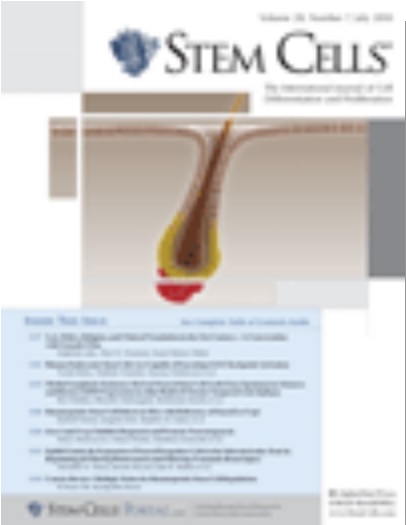- Submit a Protocol
- Receive Our Alerts
- Log in
- /
- Sign up
- My Bio Page
- Edit My Profile
- Change Password
- Log Out
- EN
- EN - English
- CN - 中文
- Protocols
- Articles and Issues
- For Authors
- About
- Become a Reviewer
- EN - English
- CN - 中文
- Home
- Protocols
- Articles and Issues
- For Authors
- About
- Become a Reviewer
Chemosensitivity Assay
Published: Vol 3, Iss 17, Sep 5, 2013 DOI: 10.21769/BioProtoc.891 Views: 12620
Reviewed by: Fanglian HeLin FangAnonymous reviewer(s)

Protocol Collections
Comprehensive collections of detailed, peer-reviewed protocols focusing on specific topics
Related protocols

Accurate Identification of Cell Cycle Stages in RPE1 Cells Using the ImmunoCellCycle-ID Method
Syon Reddy [...] Aussie Suzuki
Aug 5, 2025 1796 Views
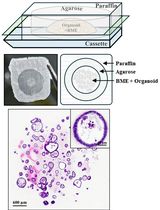
Generation of Agarose-Based FFPE Cancer Organoids for Morphology Preservation
Mi Rim Lee [...] Yun-Hee Kim
Oct 5, 2025 1564 Views
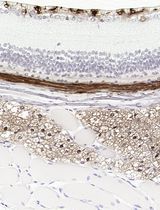
Improved Immunohistochemistry of Mouse Eye Sections Using Davidson's Fixative and Melanin Bleaching
Anne Nathalie Longakit [...] Catherine D. Van Raamsdonk
Nov 20, 2025 1476 Views
Abstract
Chemoresistance is one of the special properties of cancer stem cells, which is the main cause of chemotherapy failure and plays an important role in the recurrence of various cancers including osteosarcoma. The most widely used assay for evaluating chemoresistance is the modified cell proliferation assay. An equal number of cells are seeded onto 96-well culture plates or 24-well plates, and then different concentrations of anti-cancer drugs are added into each well. After that, measure the cell density or cell activity to observe the effect of anti-cancer drugs to cancer cells or cancer stem cells. The chemoresistance of cells is stronger, the cell density or cell activity is higher. Here, we describe chemosensitivity assays for osteosarcoma cells and osteosarcoma stem-like cells.
Materials and Reagents
- Osteosarcom cell line MNNG/HOS# from the cell bank of the Chinese Academy of Sciences (Shanghai, China)
- Dulbecco’s Modified Eagle’s Medium/Nutrient Mixture F-12 Ham (DF) (Sigma-Aldrich, catalog number: D8900 )
- Fetal Bovine Serum (FBS) (Hyclone, catalog number: GUC SH30084 )
- NaCl (Wako Chemicals USA, catalog number: 191-01665 )
- KCl (Wako Chemicals USA, catalog number: 163-03545 )
- Na2HPO4 (Wako Chemicals USA, catalog number: 197-02865 )
- KH2PO4 (Wako Chemicals USA, catalog number: 169-04245 )
- Trypsin (0.05%) (Sigma-Aldrich, catalog number: T4799 )
- EDTA (0.04%) (Sigma-Aldrich, catalog number: E6758 )
- Trypsin inhibitor (0.05%) (Sigma-Aldrich, catalog number: T9128 )
- CellTiter 96® AQueous One Solution Cell Proliferation Assay kit (Promega Corporation, catalog number: G3582 )
- Cisplatin (Sigma-Aldrich, catalog number: P4394 )
- Adriamycin (Sigma-Aldrich, catalog number: D1515 )
- Agarose (Sigma-Aldrich, catalog number: A9539 )
- Type I collagen (Life Technologies, Gibco®, catalog number: 17100-017 )
- Collagenase I (Sigma-Aldrich, catalog number: C3867 )
- Collagenase IV (Life Technologies, Gibco®, catalog number: 17104-019 )
- Insulin (Sigma-Aldrich, catalog number: I5500 )
- Apo-Transferrin (Sigma-Aldrich, catalog number: T2252 )
- 2-mercaptoethanol (Sigma-Aldrich, catalog number: M7522 )
- Ethanolamine (Sigma-Aldrich, catalog number: E0135 )
- Sodium selenite (Sigma-Aldrich, catalog number: S5261 )
- BSA (Sigma-Aldrich, catalog number: A6003 )
- Oleic acid (Sigma-Aldrich, catalog number: O1383 )
- Heparin (Sigma-Aldrich, catalog number: H3149 )
- L-Ascorbic acid 2-phosphate trisodium salt (Wako Chemicals USA, catalog number: 323-44822 )
- Milli Q water
- TGF-β1 signaling inhibitor SB431542 (Biovision, catalog number: 1674-1 )
- Dimethyl Sulfoxide (DMSO) (Sigma-Aldrich, catalog number: D5879 )
- PBS without Ca2+ and Mg2+ (see Recipes)
- Serum-Free medium (see Recipes)
- Cancer stem cell medium (see Recipes)
Equipment
- Centrifuge (Thermo Heraeus Megafuge 1.0)
- CO2 cell culture incubator (NuAire, model: nu8700E )
- Microscope (Nikon corporation Japan, model: Nikon Eclipse Ti-U )
- Microplate Reader 680 (Bio-Rad Laboratories, model: 168-1001 )
- Coulter Counter (Beckman Coulter, model: Z1 )
- Volume adjustable micropipet (Gilson 1-10 μl, model: FA10002M ; 10-100 μl, model: FA10004M ; 100-1,000 μl, model: FM10006M )
- Multichannel pipettor (BIOHIT mline pipettor, model: 725140 )
- 10 ml Glass pipette (BrandTech, model: 27713 )
- Electric pipette (BrandTech, model: accu-jet pro 2026330 )
- 96-well culture plate (Greiner Bio-One GmbH, catalog number: 655180 )
- 24-well plate (Greiner Bio-One GmbH, catalog number: 665180 )
- 50 ml centrifuge tube
Procedure
- For serum cultured monolayer cells in 96-well plate
- Maintain stock culture of monolayer cells in DF medium supplemented with 10% FBS (Figure 1).
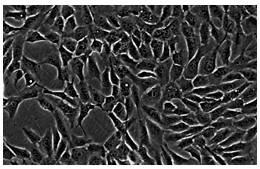
Figure 1. Osteosarcoma cells MNNG/HOS#
- When monolayer cells are 80~90% confluent, discard medium and wash cells once with 2 ml 1x PBS, and then digest cells with 1 ml trypsin-EDTA for 2-5 min at 37 °C.
- Check cell status under microscope. When the cells are disassociated, terminate digestive reaction with the same volume of FBS.
- Pipette cells into 50 ml centrifuge tube, and collect cells by centrifugation at 800 rpm for 5 min.
- Suspend cell pellet by DF medium without antibiotics. DF medium used for chemosensitivity assay are antibiotics free.
- Count the cells by Coulter Counter.
- Adjust cell density at 50,000 cells/ml by DF medium supplemented with 5% FBS.
- Dispense 100 μl of cell suspension (50,000 cells/ml) in a 96-well plate.
- Incubate the cells for 24 h in a humidified incubator (at 37 °C, 5% CO2).
- Add 1 μl of various concentrations of adriamycin or cisplatin into each well of the 96-well assay plate containing the cells, and shake the 96-well plate horizontally to mix the drugs (do not need to change the medium).
- Incubate the cells for 72 h in a humidified incubator (at 37 °C, 5% CO2).
- Thaw the CellTiter 96® AQueous One solution reagent. It should take approximately 90 minutes at room temperature, or 10 min in a water bath at 37 °C, to completely thaw the 20 ml size.
- Pipette 20 μl of CellTiter 96® AQueous One solution reagent into each well of the 96-well assay plate containing the cells in 100 μl of culture medium, and shake the 96-well plate horizontally to mix the reagent (Do not need to change the medium).
- Incubate the plate at 37 °C for 2 h in a humidified incubator (at 37 °C, 5% CO2).
- Record the absorbance at 490 nm using a Microplate Reader 680.
- Maintain stock culture of monolayer cells in DF medium supplemented with 10% FBS (Figure 1).
- For serum-free cultured monolayer cells in 24-well plate
- Preparation for 24-well plate:
- Prepare 1% type I collagen solution with chilled 1x PBS.
- Add 0.5 ml collagen solution into each well of 24-well plate.
- Stand 24-well plate for 1 h at room temperature.
- Aspirate excess collagen solution, and rinse the well with 1x PBS once.
- Aspirate 1x PBS completely.
- Prepare 1% type I collagen solution with chilled 1x PBS.
- Maintain stock culture of monolayer cells in DF medium supplemented with 10% FBS.
- When monolayer cells are 80~90% confluent, discard medium and wash cells once in 2 ml 1x PBS.
- Digest cells with 1 ml trypsin-EDTA for 2-5 min at 37 °C.
- Check cell status under microscope. When the cells are disassociated, terminate digestive reaction with the same volume of trypsin inhibitor.
- Pipette cells into 50 ml centrifuge tube, and collect cell by centrifugation at 800 rpm for 5 min.
- Suspend cell pellet by DF medium without antibiotics. DF medium used for chemoresistance assay are antibiotics free.
- Count the cells by Coulter Counter.
- Adjust cell density at 20,000/ml by serum free DF medium.
- Add 1 ml cell solution onto each well of 24-well plate.
- Incubate the cell for 24 h.
- Add various concentrations of adriamycin or cisplatin into each well of 24-well plate containing the cells, and shake the 24-well plate horizontally to mix the drugs (do not need to change the medium).
- Incubate cells for another 3 days.
- Discard supernatant, rinse each well by 1x PBS.
- Add 0.5 ml trypsin-EDTA to each well.
- Collect disassociated cells, and count cell number by Coulter Counter.
- Preparation for 24-well plate:
- For spheroid cells
- Preparation for 96-well plate:
- Dissolve agarose powder in Milli Q water.
- Prepare 0.7% agarose solution, sterilized by autoclave for use.
- Dispense 20 μl of 0.7% agarose into each well of 96-well plate.
- Stand 96-well plate for 20 min at room temperature.
- The 96-well plate could be used after agarose solidification.
- Dissolve agarose powder in Milli Q water.
- Maintain stock culture of osteosarcoma spheroid cells in cancer stem cell medium (Figure 2).
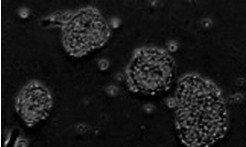
Figure 2. Osteosarcoma spheres. The spheroid cells are suspended cultured in cancer stem cell medium.
- When spheres reach 100 μm in diameter, pipette spheres into 50 ml centrifuge tube and collect cells by centrifugation at 500 rpm for 3 min.
- Discard the supernatant; digest spheres with the mixture of trypsin (0.05%), collagenase I (0.1%) and collagenase IV (0.1%) for 2 min at 37 °C.
- When spheres are digested to be single cells, terminate digestive reaction with 0.05% trypsin inhibitor.
- Collect cells by centrifugation at 800 rpm for 5 min. Suspend cell pellet by cancer stem cell medium without antibiotics. Cancer stem cell medium used for chemosensitivity assay are antibiotics free.
- Count the cells by Coulter Counter.
- Adjust cell density at 50,000 cells/ml by cancer stem cell medium.
- Dispense 100 μl of cell suspension (50,000 cells/ml) onto each agarose coated well of 96-well plate.
- Incubate the cells for 24 h in a humidified incubator (at 37 °C, 5% CO2).
- Add 1 μl of various concentrations of adriamycin or cisplatin into each well of 96-well plate containing the cells, and shake the 96-well plate horizontally to mix the drugs (do not need to change the medium).
- Incubate the cells for 72 h in a humidified incubator (at 37 °C, 5% CO2).
- Thaw the CellTiter 96® AQueous One solution reagent.
- Pipette 20 μl of CellTiter 96® AQueous One solution reagent into each well of the 96-well plate containing the cells in 100 μl of culture medium, and shake the 96-well plate horizontally to mix the reagent (Do not need to change the medium).
- Incubate the plate at 37 °C for 2 h in a humidified incubator (at 37 °C, 5% CO2).
- Record the absorbance at 490 nm using a Microplate Reader 680.
- Preparation for 96-well plate:
- For spheroid cells which are pre-treated with TGF-β1 signaling inhibitor SB431542.
- Preparation for 96-well plate:
- Dissolve agarose powder in Milli Q water.
- Prepare 0.7% agarose solution, sterilized by autoclave for use.
- Dispense 20 μl of 0.7% agarose into each well of 96-well plate.
- Stand 96-well plate for 20 min at room temperature.
- The 96-well plate could be used after agarose solidification.
- Dissolve agarose powder in Milli Q water.
- Maintain stock culture of osteosarcoma spheroid cells in cancer stem cell medium.
- Osteosarcoma spheroid cells are pre-treated with 376 nM SB431542 (dissolved in 0.01% DMSO) for 3 days (or pre-treated with 0.01% of DMSO for control) in cancer stem cell medium.
- Pipette spheres into 50 ml centriguge tube and collect cells by centrifugation at 500 rpm for 3 minutes.
- Discard the supernatant; digest spheres with the mixture of trypsin (0.05%), collagenase I (0.1%) and collagenase IV (0.1%) for 2 min at 37 °C.
- When spheres are digested to be single cells, terminate digestive reaction with 0.05% trypsin inhibitor.
- Collect cells by centrifugation at 800 rpm for 5 min. Suspend cell pellet by cancer stem cell medium without antibiotics. Cancer stem cell medium used for chemoresistance assay are antibiotics free.
- Determine cell number by Coulter Counter.
- Adjust cell density at 50,000 cells/ml by cancer stem cell medium.
- Dispense 100 μl of cell suspension (5,000 cells/well) onto each agarose coated well of 96-well plate.
- Incubate the cells for 24 h in a humidified incubator (at 37 °C, 5% CO2).
- Add 1 μl of various concentrations of adriamycin or cisplatin into each well of 96-well plate containing the cells, and shake the 96-well plate horizontally to mix the drugs (do not need to change the medium).
- Incubate the cells for 72 h in a humidified incubator (at 37 °C, 5% CO2).
- Thaw the CellTiter 96® AQueous One solution reagent.
- Pipette 20 μl of CellTiter 96® AQueous One solution reagent into each well of the 96-well plate containing the cells in 100 μl of culture medium, and shake the 96-well plate horizontally to mix the reagent (Do not need to change the medium).
- Incubate the plate at 37 °C for 2 h in a humidified incubator (at 37 °C, 5% CO2).
- Record the absorbance at 490 nm using a Microplate Reader 680.
- Preparation for 96-well plate:
Recipes
- PBS without Ca2+ and Mg2+
8 g/L NaCl
0.2 g/L KCl
1.42 g/L Na2HPO4
0.27 g/L KH2PO4
- Serum-Free medium
2.5 mg/L Insulin
5 mg/L apo-Transferrin
1 mM 2-mercaptoethanol
1 mM Ethanolamine
1 μM Sodium selenite
- Cancer stem cell medium
Insulin (10 mg/L)
Apo-Transferrin (5 mg/L)
2-mercaptoethanol (1 mM)
Ethanolamine (1 mM)
Sodium selenite (2 μM)
BSA (9.4 mg/L)
Oleic acid (1.88 mg/L)
Heparin (150 μg/L)
L-Ascorbic acid 2-phosphate trisodium salt (10 mg/L)
Acknowledgments
This study was supported in part by a grant from the program of the State High-Tech Development Project (No. 2008AA092604), National Basic Research Program (No. 2009CB945400) and Guangdong Planning Project of Science and Technology (No. 2009B030803037).
References
- Adhikari, A. S., Agarwal, N., Wood, B. M., Porretta, C., Ruiz, B., Pochampally, R. R. and Iwakuma, T. (2010). CD117 and Stro-1 identify osteosarcoma tumor-initiating cells associated with metastasis and drug resistance. Cancer Res 70(11): 4602-4612.
- Ginestier, C., Liu, S., Diebel, M. E., Korkaya, H., Luo, M., Brown, M., Wicinski, J., Cabaud, O., Charafe-Jauffret, E., Birnbaum, D., Guan, J. L., Dontu, G. and Wicha, M. S. (2010). CXCR1 blockade selectively targets human breast cancer stem cells in vitro and in xenografts. J Clin Invest 120(2): 485-497.
- Haraguchi, N., Ishii, H., Mimori, K., Tanaka, F., Ohkuma, M., Kim, H. M., Akita, H., Takiuchi, D., Hatano, H., Nagano, H., Barnard, G. F., Doki, Y. and Mori, M. (2010). CD13 is a therapeutic target in human liver cancer stem cells. J Clin Invest 120(9): 3326-3339.
- Zhang, H., Wu, H., Zheng, J., Yu, P., Xu, L., Jiang, P., Gao, J., Wang, H. and Zhang, Y. (2013). Transforming growth factor beta1 signal is crucial for dedifferentiation of cancer cells to cancer stem cells in osteosarcoma. Stem Cells 31(3): 433-446.
Article Information
Copyright
© 2013 The Authors; exclusive licensee Bio-protocol LLC.
How to cite
Zhang, H. and Zhang, Y. (2013). Chemosensitivity Assay. Bio-protocol 3(17): e891. DOI: 10.21769/BioProtoc.891.
Category
Cancer Biology > Cell death > Drug discovery and analysis > Cell viability
Cancer Biology > General technique > Cell biology assays > Chemoresistance
Cell Biology > Cell viability > Cell proliferation
Do you have any questions about this protocol?
Post your question to gather feedback from the community. We will also invite the authors of this article to respond.
Share
Bluesky
X
Copy link




